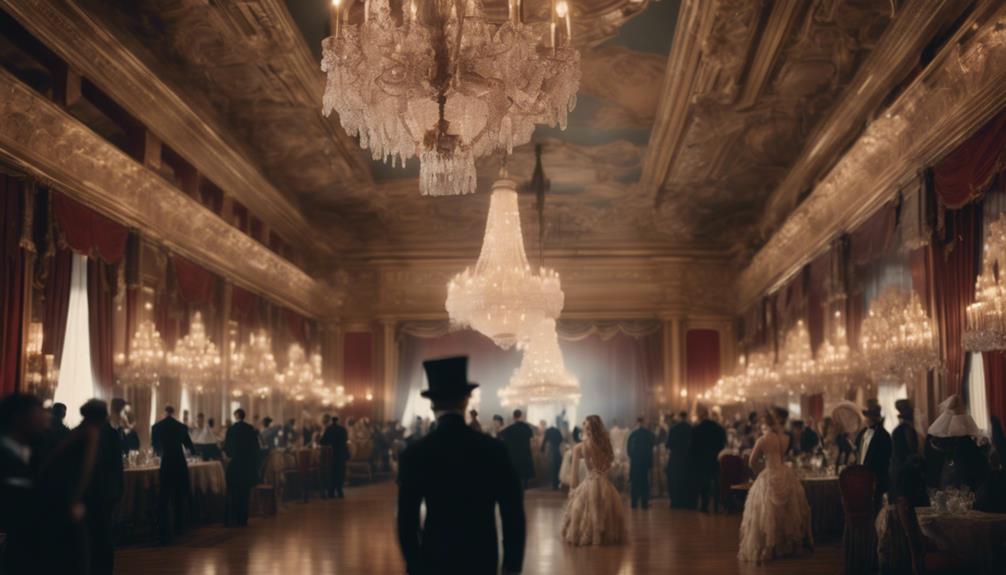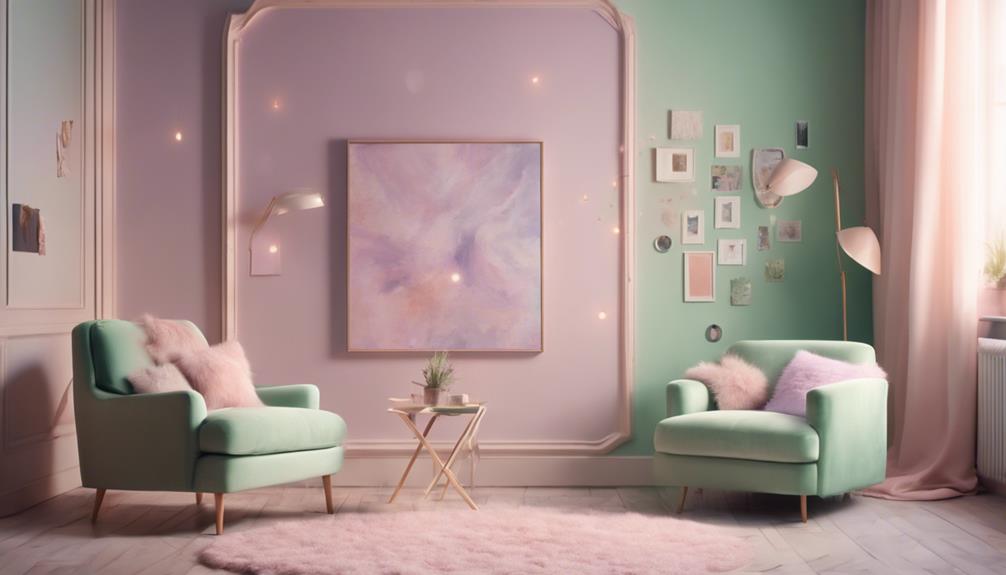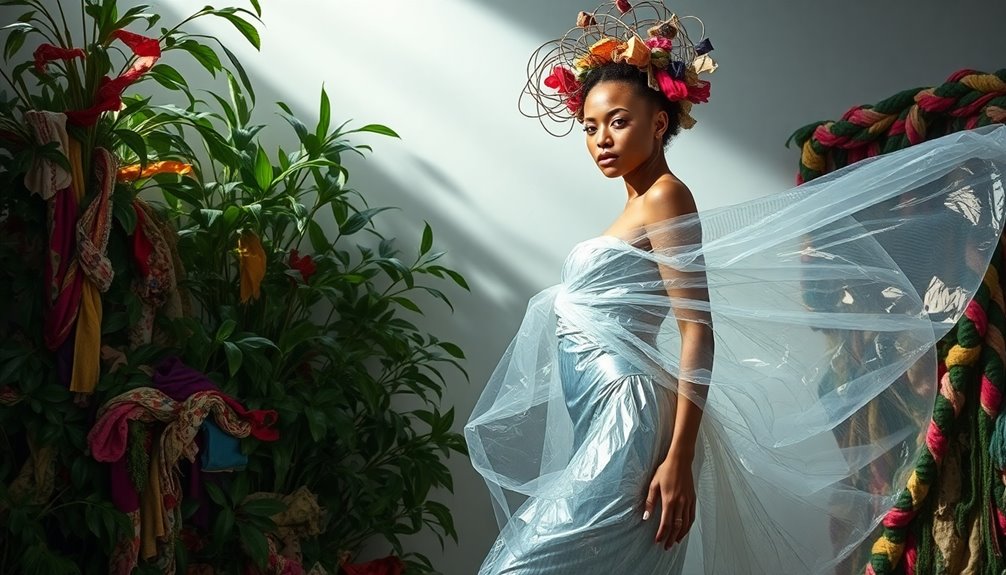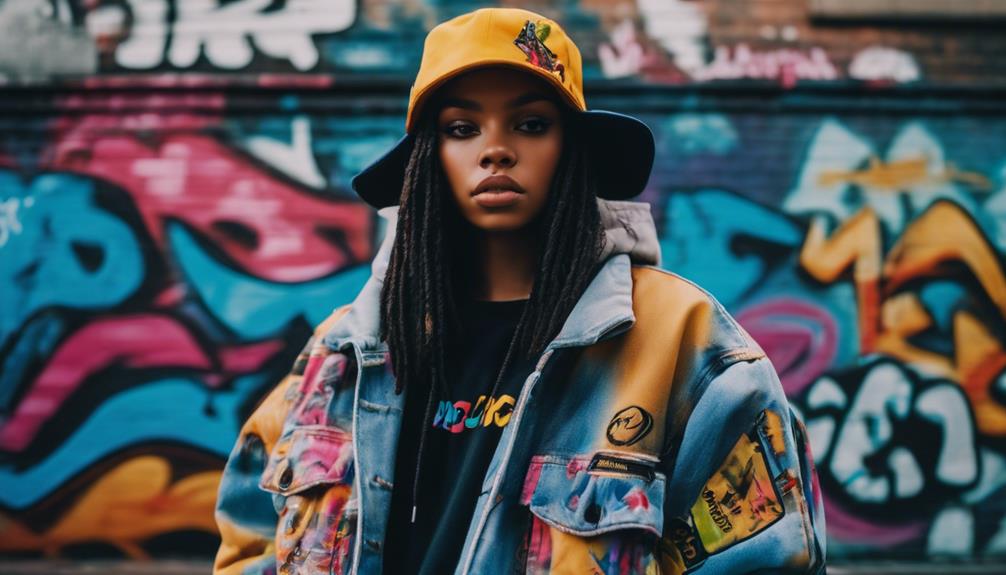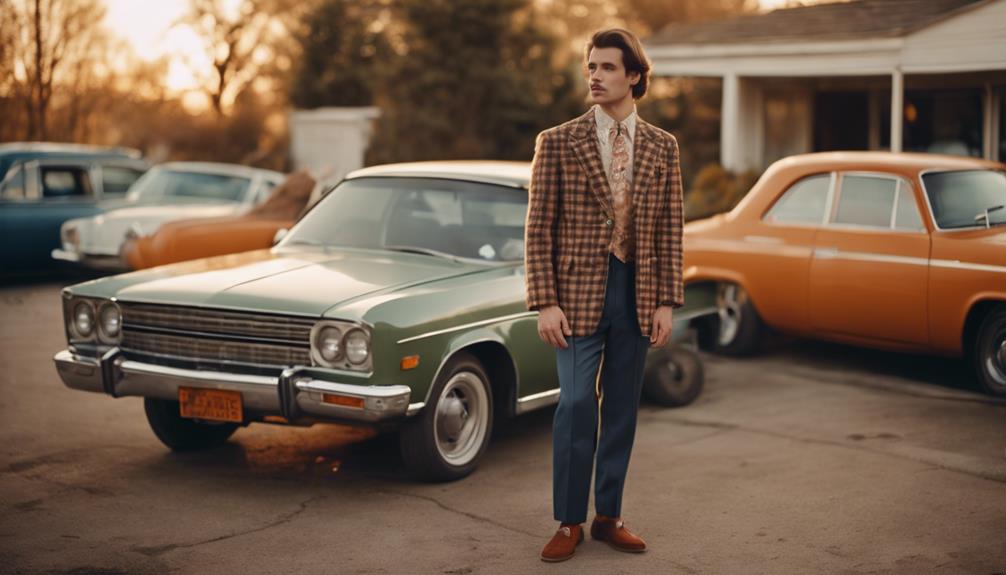The fashion of the Victorian era embodies a sense of timeless elegance with its luxurious textures and intricate details. Corsets, bustle skirts, and vibrant fabrics such as velvet not only represent social status but also unveil a captivating history. This period revolutionized fashion from opulent aristocracy to attainable sophistication, heavily influenced by Queen Victoria herself. Present-day interpretations combine these traditional elements with current trends, making Victorian fashion a popular choice in modern style. As you delve deeper, you will discover fashion tips and a plethora of cultural significance, ensuring that the appeal of Victorian fashion remains enchanting and inspiring in today’s society.
Key Takeaways
- Victorian fashion evolved through distinct periods, reflecting societal changes and royal influences, particularly from Queen Victoria's preferences.
- Key characteristics include corsets and bustle skirts that shaped the iconic hourglass silhouette, symbolizing wealth and status.
- Luxurious materials like velvet and intricate lace showcased craftsmanship, with rich colors representing the opulence of the era.
- The suffrage movement led to practical fashion changes, prioritizing comfort with looser skirts and tailored jackets for activism.
Origin and historical background of the fashion trend/style
You'll notice how fashion transformed throughout the Victorian era, reflecting the changing society and the influence of royalty.
As the middle class grew, their tastes started shaping trends, moving from the lavish styles of aristocrats to more accessible designs.
Understanding this evolution helps you appreciate the rich tapestry of Victorian fashion history.
Fashion's Transformation Through Decades
Fashion underwent remarkable transformation throughout the Victorian era, evolving from the elaborate hourglass silhouettes of the early years to the simpler, yet artistically embellished styles of the late period.
In the early Victorian era (1837-1850s), you'd notice the focus on corsets and voluminous skirts, emphasizing a strict ideal of femininity and modesty. This style showcased the social status of women, highlighting their roles within society.
As you move into the mid-Victorian era (1860s-1870s), crinolines and bustles took center stage, expanding skirt silhouettes while maintaining intricate detailing and luxurious fabrics. This shift reflected the growing wealth of the middle class, making Victorian fashion a symbol of social mobility.
Royalty and Aristocratic Fashion
Influenced by Queen Victoria's iconic choices, royalty and aristocrats defined their status through elaborate and meticulously crafted garments that reflected both personal taste and societal expectations. This era marked a significant shift in aristocratic fashion, particularly after Victoria's choice of a white wedding gown in 1840, which sparked a trend still seen today.
Wealthy individuals embraced opulent fabrics like silk, satin, and velvet, showcasing their affluence through intricate lace and embroidery. The fashion of the time adhered to strict social norms, dictating distinct attire for various occasions. Women donned elaborate evening gowns, while men sported tailored suits paired with top hats at formal events.
The custom-tailored garments of this period highlighted individuality, as skilled artisans crafted unique pieces that emphasized both personal style and opulence. Aristocratic fashion also reflected broader cultural trends, with garments adorned by artistic embellishments inspired by literature, art movements, and architectural styles.
This intersection of personal expression and societal expectation established a fashion legacy that continues to influence modern styles, ensuring that the elegance of royalty and aristocratic fashion remains a timeless reference point for fashion enthusiasts today.
Key Characteristics
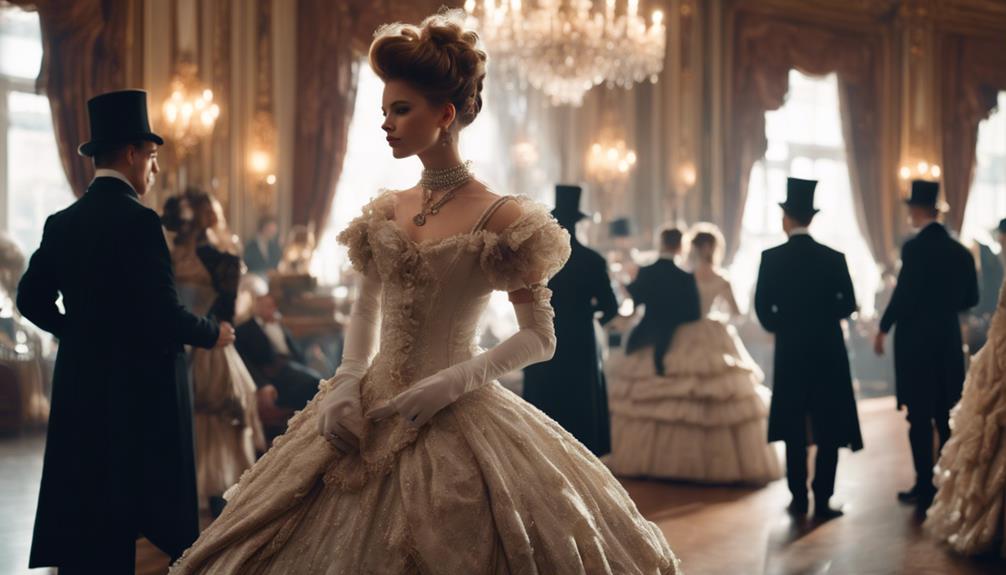
When you think about Victorian era fashion, several key characteristics stand out.
You'll notice the intricate lace and embroidery that adorned garments, along with the rich velvet fabrics in deep hues.
Corsets and bustle skirts also played an essential role in shaping the iconic silhouettes of the time.
Intricate Lace and Embroidery
Intricate lace and embroidery define the elegance of Victorian attire, showcasing remarkable craftsmanship and attention to detail. As you explore Victorian fashion, you'll notice that intricate lace was a hallmark, embellishing gowns, blouses, and accessories. This delicate work not only added beauty but also served practical purposes, like providing ventilation in layered garments.
Victorian embroidery techniques, such as satin stitch and chain stitch, created elaborate floral and geometric patterns that enhanced the visual richness of each piece. You'll see how these designs often reflected nature, showcasing the era's fascination with the natural world. This connection to nature inspired countless artisans to create stunning works of art on fabric.
Using luxurious materials like silk and cotton, Victorian lace and embroidery contributed to the opulent aesthetic that characterized the period. The combination of intricate lace and masterful embroidery techniques made each garment a unique statement of elegance.
When you appreciate these details, you truly understand the enduring allure of Victorian fashion, which continues to inspire modern styles today. So, whether you're dressing up for a special occasion or simply admiring the art, remember the craftsmanship behind these timeless pieces.
Rich Velvet and Deep Hues
Rich velvet fabrics and deep hues defined the opulent style of Victorian fashion, making garments not just beautiful but also a symbol of wealth and status. You'll find that these luxurious textures were staples in the wardrobes of the wealthy, enhancing the grandeur of their attire. Rich velvet was favored for evening gowns and accessories, showcasing its ability to convey opulence and sophistication.
Deep hues like burgundy, emerald green, and royal blue were common choices, reflecting the era's preference for a dramatic color palette. These colors didn't just make a bold statement; they also indicated social standing, as high-quality materials were expensive and often reserved for the upper classes. The interplay between rich velvet fabrics and these deep hues created a visual richness that captivated and influenced Victorian society.
Moreover, the intricate patterns often woven into the velvet added another layer of elegance, further enhancing the luxurious feel of the garments. Today, the enduring appeal of these characteristics continues to inspire modern fashion design, reminding us of the timeless allure that rich velvet and deep hues bring to any wardrobe.
Corsets and Bustle Skirts
Corsets and bustle skirts played an essential role in shaping the distinctive silhouette of Victorian fashion, creating an idealized hourglass figure that emphasized femininity and elegance. Corsets were designed to tightly lace the waist, often constructed with steel boning for support. This exaggerated silhouette became synonymous with Victorian elegance, as women aimed to achieve that coveted small waist.
As the Victorian era progressed, bustle skirts emerged, adding fullness at the back while maintaining a fitted front. This design accentuated the curves of the hips, further enhancing the feminine form. Made from luxurious fabrics like silk and velvet, these skirts were layered and adorned with intricate embellishments, showcasing the wearer's wealth and status.
However, the quest for beauty came with health implications. Many women experienced respiratory issues and digestive complications due to the tight-lacing of corsets, which were often overlooked in pursuit of fashion.
Ultimately, the combination of corsets and bustle skirts not only defined a period of Victorian elegance but also dictated strict fashion etiquette for social occasions, emphasizing modesty and opulence in every detail.
Modern Interpretation
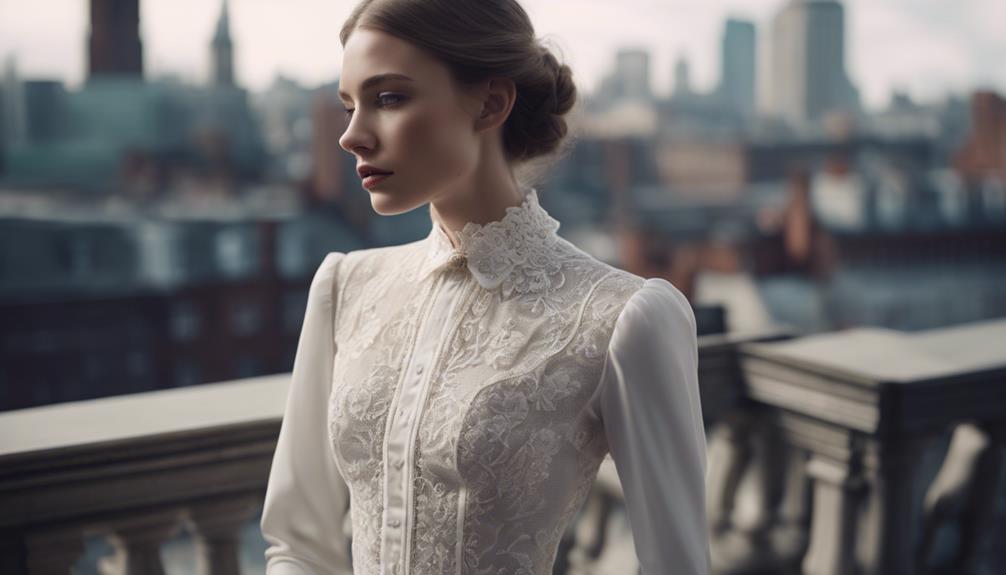
You'll notice that modern fashion often draws inspiration from the Victorian era, blending classic elements with today's trends.
Designers and fashion houses are reimagining high collars and corsets, making them both stylish and comfortable.
This revival not only celebrates historical influences but also showcases fashion icons who embody this neo-Victorian aesthetic.
Neo-Victorian Influences in Fashion
Neo-Victorian fashion seamlessly blends historical elegance with contemporary aesthetics, featuring elements like lace, high collars, and structured silhouettes. This style captures the intricate details that defined the Victorian era while adapting them for modern wear. You'll find that lace gloves, cameo brooches, and chokers are popular accessories that add vintage charm and sophistication to your everyday outfits.
Fashion designers, including Viktor & Rolf, have taken inspiration from Victorian styles, incorporating rich fabrics and intricate designs into their collections. This revival isn't just limited to runways; it extends to themed events and vintage markets, where you can see how the neo-Victorian trend continues to flourish.
Social media platforms play a significant role in this resurgence, allowing individuals to showcase their neo-Victorian outfits. These spaces highlight how this style serves as a form of personal expression, inviting you to embrace a blend of past and present.
Renowned Neo-Victorian Fashion Houses
Renowned fashion houses like Alexander McQueen and Vivienne Westwood skillfully weave Victorian elements into their collections, creating modern interpretations that celebrate the era's opulence. These designers embrace neo-Victorian aesthetics, incorporating features such as corsetry, lace, and rich fabrics that echo the grandeur of the past.
You'll find that brands like Viktor & Rolf blend historical motifs with contemporary silhouettes, crafting Victorian-inspired pieces that resonate with nostalgia while feeling fresh and innovative. High-profile collections from Gucci also showcase this trend, highlighting ruffled collars and ornate prints that pay homage to Victorian style.
Meanwhile, Marchesa and Oscar de la Renta frequently present gowns with voluminous skirts and elaborate lacework, merging classic elegance with today's fashion trends, perfect for bridal or evening wear.
The Neo-Victorian movement thrives in contemporary fashion, celebrated through themed events and vintage markets that display the enduring influence of Victorian style. You'll see how these fashion houses not only respect the past but also redefine it, ensuring that timeless fashion continues to inspire future generations.
With each piece, they invite you to experience the luxurious spirit of the Victorian era reimagined for today's world.
Fashion Icons of the Era
Fashion icons from the Victorian era, like Queen Victoria and Lillie Langtry, continue to inspire modern designers with their timeless elegance and innovative styles. Queen Victoria, who popularized the white wedding dress trend in 1840, set a standard that still influences bridal fashion today. Lillie Langtry, known for her luxurious gowns, blended opulence with contemporary flair, creating a legacy that resonates in today's fashion.
Empress Eugenie of France showcased extravagant styles, adorned with lace and embroidery, which transcended borders and profoundly impacted European fashion. The Pre-Raphaelite artists, including Dante Gabriel Rossetti, drew inspiration from Victorian society, emphasizing women in flowing, ethereal garments that celebrated natural beauty and romanticism.
Moreover, the late Victorian era saw the rise of fashion plates in magazines like 'Harper's Bazaar,' which helped disseminate the looks of these fashion icons, making luxurious styles accessible to the growing middle class.
Today, you can see echoes of this Victorian influence in modern couture, where designers draw upon the rich aesthetics of the past while adding fresh interpretations. So, when you embrace Victorian-inspired fashion, you're not just wearing clothes; you're connecting with a legacy of timeless elegance.
Styling Tips
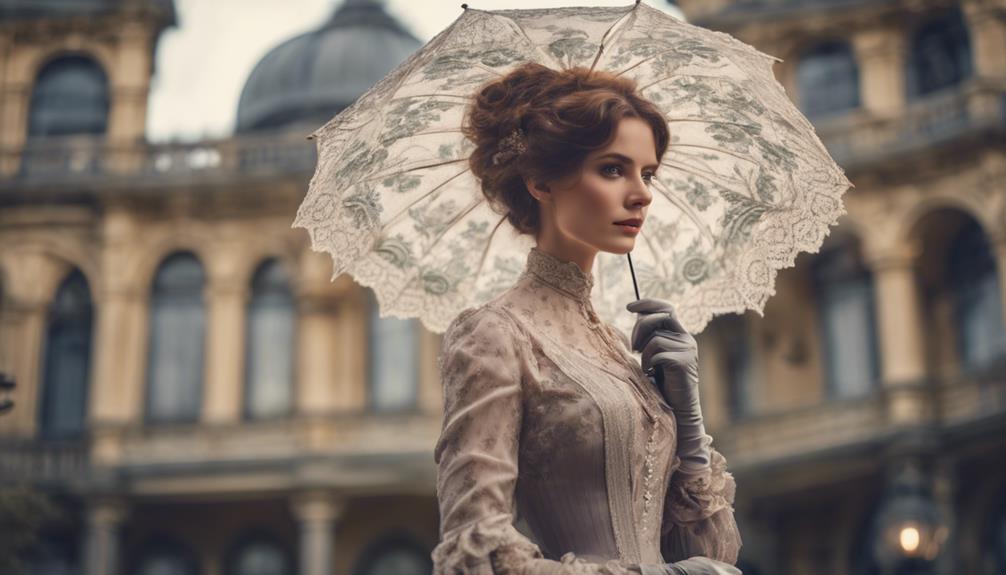
When you're aiming for a Victorian-inspired look, start with statement accessories that capture the era's elegance.
Layering textures and patterns is essential, so mix rich fabrics to create a visually stunning ensemble.
Victorian-Inspired Statement Accessories
Victorian-inspired statement accessories can transform your outfit, adding a touch of elegance and vintage charm to any look. One of the easiest ways to channel the Victorian era is by incorporating lace gloves. These delicate additions enhance both formal and casual outfits, providing a refined touch.
Cameo brooches are another fantastic option; their intricate carvings serve as striking statement accessories that can be pinned to jackets or even worn in your hair for a whimsical flair. For a more dramatic effect, style chokers in lace or velvet around your neck. Often adorned with charms or pendants, they evoke the opulent aesthetic of the Victorian era.
Don't overlook the versatility of top hats. Pair them with tailored suits or feminine dresses for a sophisticated look that pays homage to Victorian elegance.
Finally, consider decorative parasols—not only do they offer practical sun protection, but they also serve as stylish accessories that complement your Victorian-inspired outfits beautifully.
Victorian-Inspired Layered Ensembles
To create a stunning layered ensemble that captures the essence of Victorian style, start with a high-necked blouse and a structured corset to define your silhouette. This foundational piece sets the tone for your Victorian-inspired look.
Next, opt for a voluminous skirt or dress featuring crinolines or bustles, which will create the iconic hourglass shape associated with Victorian fashion. Choose rich fabrics like silk or velvet to enhance the elegance of your outfit.
Layer your ensemble with elegant outerwear, such as a tailored jacket or a long coat. Look for pieces adorned with lace or intricate embroidery to elevate the opulent aesthetic.
Accessories play a vital role in achieving that authentic Victorian flair. Incorporate period-appropriate items like lace gloves, a choker, or a vintage-inspired hat to add sophistication and detail to your layered look.
Layering Textures and Patterns
Incorporating a variety of textures and patterns can instantly elevate your layered ensemble, creating a rich, visually stunning aesthetic that pays homage to the opulence of the Victorian era.
Start by layering textures—mix plush velvets with delicate lace for a luxurious feel. This combination not only reflects the intricate designs favored during that time but also adds depth to your outfit.
Don't shy away from mixing patterns, too. Pair damask upholstery prints with floral motifs to create a mesmerizing look that's both bold and elegant. Remember to utilize various fabric weights; heavier materials like brocade can be beautifully complemented by lighter fabrics like chiffon, enhancing the silhouette and movement.
Accessorizing is key to achieving that Victorian attention to detail. A lace-trimmed shawl draped over a structured bodice can serve as an exquisite focal point.
Finally, emphasize contrasting colors, such as deep greens against golds, to echo the rich palette characteristic of Victorian style while ensuring your overall look remains cohesive.
With these tips, you'll master the art of layering textures and patterns, embodying the timeless elegance of the Victorian era in your wardrobe.
Shopping Guide
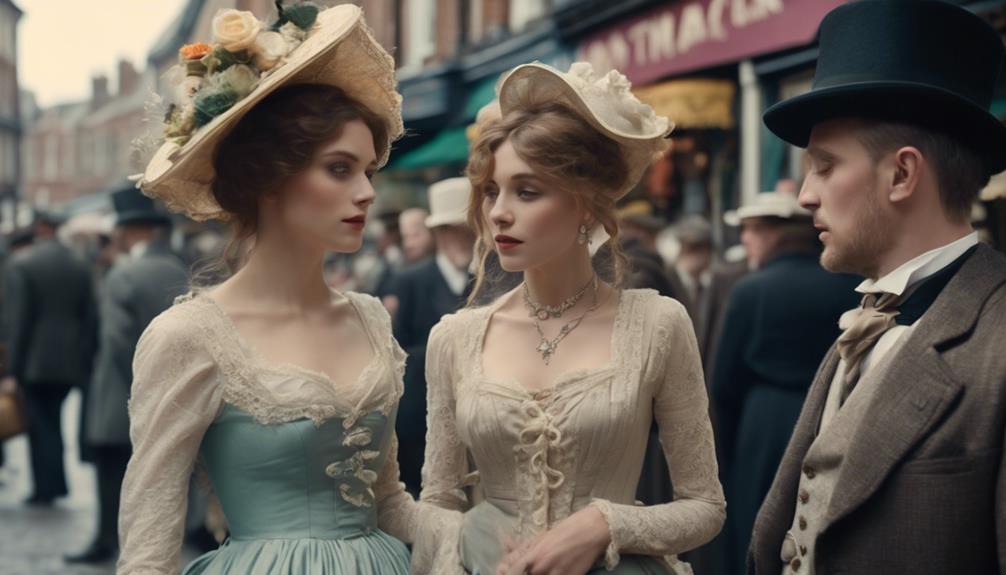
When you shop for Victorian fashion, focus on luxurious materials like silk, satin, and velvet that capture the era's opulence. Look for dresses featuring voluminous skirts, high necklines, and corsetry details to achieve that iconic silhouette. These elements not only reflect Victorian elegance but also enhance your figure beautifully.
Explore vintage markets or specialized boutiques for neo-Victorian accessories. Lace gloves, cameo brooches, and chokers can elevate your outfit, adding a touch of historical charm. Don't overlook the importance of craftsmanship; garments with intricate detailing showcase quality construction, a hallmark of Victorian fashion.
Consider the occasion when selecting your attire. Whether you're attending a formal event or a themed gathering, make certain your choices align with the expected fashion etiquette. This will help you embody the spirit of the Victorian era while maintaining a modern twist.
Lastly, pay attention to hairstyles, as intricate hairstyles were a key component of Victorian fashion. Incorporate elegant updos or soft curls to complete your look, making sure you're ready to turn heads and celebrate the classic elegance that endures!
Upcycling Vintage Victorian Fabrics
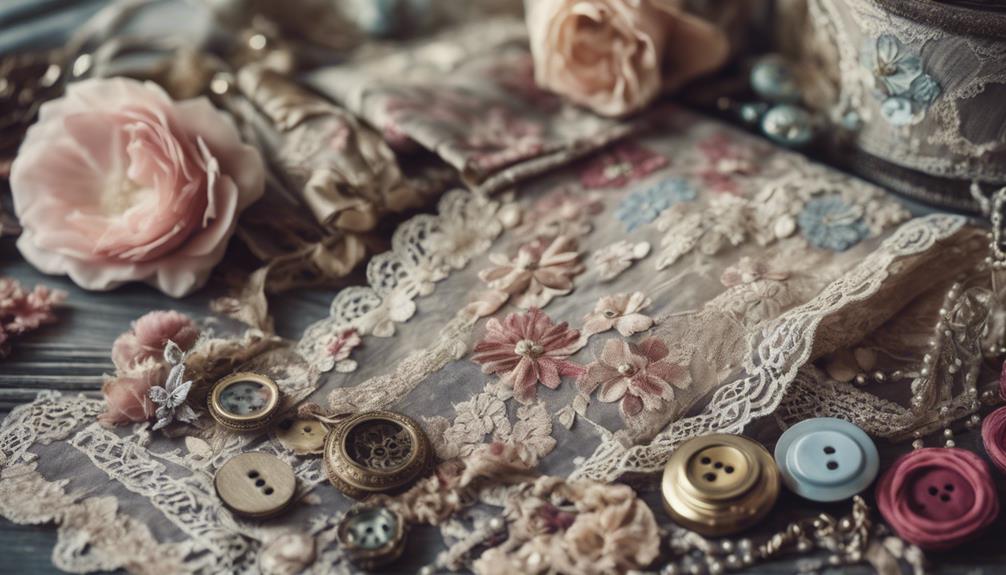
When you repurpose antique lace and vintage fabrics, you're not just creating something new; you're honoring the craftsmanship of the Victorian era.
This process allows you to incorporate beautiful textures and patterns into modern designs while giving these materials a second life.
Let's explore how you can transform these exquisite textiles into unique, eco-friendly pieces.
Repurposing Antique Lace Fabrics
Repurposing antique lace fabrics from the Victorian era breathes new life into these exquisite textiles, allowing you to create unique, modern pieces that celebrate their intricate beauty. By upcycling vintage lace, you not only honor the craftsmanship of the past but also promote sustainable fashion practices. This transformation reduces waste and adds a touch of vintage elegance to contemporary style.
Many designers today creatively incorporate repurposed Victorian lace into their collections. You might consider using it for overlays on dresses, decorative elements on bags, or even as accents on jackets. The process of upcycling involves careful restoration, ensuring that these delicate fabrics maintain their allure while adapting to modern aesthetics.
Additionally, antique lace can enhance your home decor projects. Think about crafting table runners or curtains that infuse your space with historical charm and sophistication. Each piece tells a story, merging timeless beauty with present-day functionality.
Embrace the art of repurposing antique lace, and let your creativity shine as you craft stunning, one-of-a-kind items that pay homage to the elegance of the Victorian era.
Repurposing Vintage Fabrics
Upcycling vintage Victorian fabrics allows you to preserve their intricate patterns and luxurious materials while creating unique pieces that blend historical elegance with modern style. By repurposing these textiles, you contribute to sustainable fashion practices, reducing waste and giving new life to beautiful fabrics that might otherwise be discarded.
When you engage in upcycling vintage fabrics, you're not just recycling; you're celebrating the craftsmanship of the Victorian era. Techniques like patchwork or incorporating vintage lace into modern garments not only enhance your wardrobe but also create one-of-a-kind items that reflect your personal style. This is an important aspect of modern fashion, as it encourages individual expression while connecting you to history.
The rich color palettes and ornate designs of vintage Victorian fabrics can easily adapt to contemporary needs, whether in clothing or home decor. As you explore these possibilities, you'll likely gain a deeper appreciation for the influences of past styles.
Ultimately, upcycling vintage Victorian fabrics allows you to embrace sustainability, creativity, and timeless elegance, making your fashion choices both stylish and responsible.
Cultural Impact
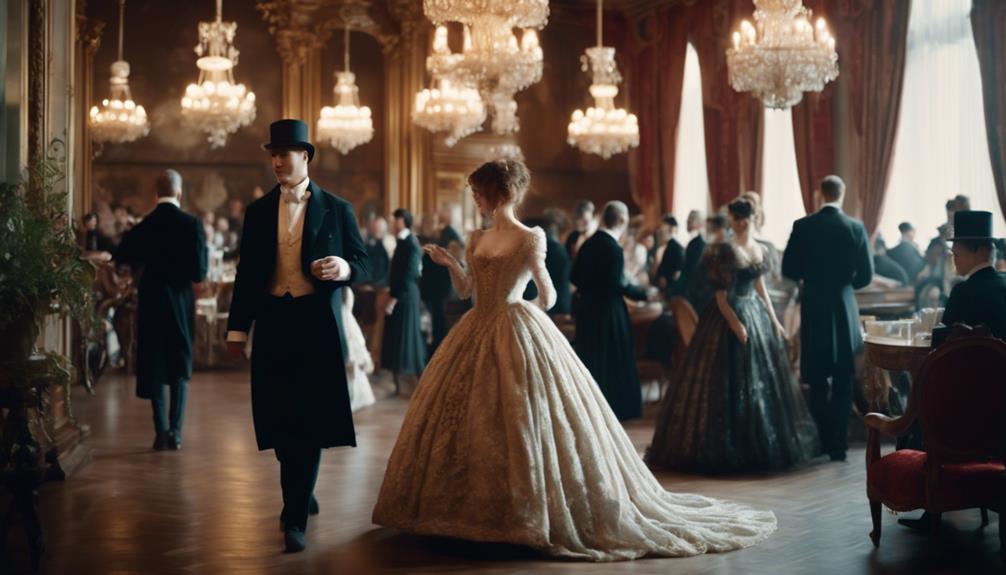
You might notice how Victorian themes frequently pop up in modern films, showcasing the era's enduring aesthetic.
Additionally, the fashion surrounding women's suffrage movements drew heavily from Victorian styles, blending activism with elegance.
These influences illustrate how the past continues to shape contemporary culture and fashion.
Victorian Themes in Modern Films
Modern films often capture the essence of Victorian fashion, immersing viewers in a world where opulence and intricate detail define the characters' societal status and elegance. Movies like 'Pride and Prejudice' and 'The Age of Innocence' showcase elaborate costumes that highlight Victorian elements, such as corsets and structured silhouettes, emphasizing the hourglass figure that symbolizes female elegance and social standing.
These films don't just stop at portraying fashion trends; they explore the societal norms and values associated with Victorian elegance. For instance, 'The Young Victoria' provides a visual narrative that reflects the cultural significance of the era while showcasing the stunning craftsmanship of garments adorned with lace, velvet, and embroidery.
The revival of Victorian themes in contemporary cinema sparks renewed interest in historical fashion, inspiring modern designers to incorporate these rich elements into their collections. By emphasizing the intricate details and artistry of Victorian attire, today's films not only entertain but also educate audiences about the era's influence on fashion and societal values, reinforcing the timeless appeal of Victorian elegance in our cultural landscape.
Women's Suffrage Fashion Influence
The women's suffrage movement transformed fashion by prioritizing comfort and practicality, allowing women to express their activism through their clothing choices.
As suffragists rallied for their rights, they embraced looser skirts and tailored jackets, facilitating their participation in protests and rallies. This shift marked a significant departure from the restrictive styles of the Victorian era.
Suffragists often donned white or light-colored garments, symbolizing purity and virtue, which contrasted sharply with the darker fashion choices of the time. The introduction of the 'suffragette sash,' featuring the colors purple, white, and green, became an emblem of the movement, worn proudly to convey political messages alongside traditional attire.
Rejecting corsets, these women favored a more natural silhouette, reflecting their desire for liberation in both politics and personal expression.
Notable suffragists like Emmeline Pankhurst used their fashion choices to challenge societal norms, blending elegance with a defiant stance against oppression. Their influence reshaped the cultural narrative around women's rights and fashion, inspiring generations to embrace clothing as a powerful tool for self-expression and activism.
Frequently Asked Questions
What Were the Key Elements of Victorian Fashion?
Victorian fashion's key elements include corsets for the hourglass figure, voluminous skirts, tailored suits, and luxurious fabrics like silk and velvet. Accessories like bonnets and top hats symbolize sophistication and social status in this era.
What Was the Main Focus of Most Victorian Era Fashions?
The main focus of most Victorian era fashions was creating an exaggerated hourglass silhouette. You'd achieve this with corsets and crinolines, emphasizing a small waist while showcasing voluminous skirts that defined the era's elegance.
What Was Victorian Era Fashion Known For?
Victorian era fashion's known for its opulent designs, intricate details, and emphasis on craftsmanship. You'll see luxurious fabrics, exaggerated silhouettes, and distinctive accessories that defined both women's and men's attire during this enthralling period.
What Were the Characteristics of the Victorian Dress?
Victorian dresses are characterized by high necklines, fitted bodices, and voluminous skirts. You'll notice the use of corsets for shaping, luxurious fabrics like silk, and dramatic silhouettes supported by crinolines or bustles.
How Can Victorian Era Fashion Influence Modern Luxury Accessories?
The opulence and sophistication of Victorian era fashion continues to influence modern luxury fashion accessories elevate elegance. From intricately designed chokers to elaborate lace gloves, the timeless elegance of this era is reflected in the intricate details and ornate embellishments of today’s luxury accessories.
Conclusion
Victorian era fashion truly embodies timeless elegance that continues to inspire today. By embracing its key characteristics, you can effortlessly incorporate vintage elements into your wardrobe.
Don't hesitate to explore modern interpretations and experiment with styling tips to make them your own. Whether you're shopping for authentic pieces or upcycling vintage fabrics, you'll not only celebrate this classic style but also keep its legacy alive.
Immerse yourself in the world of Victorian fashion and let your unique style shine!
